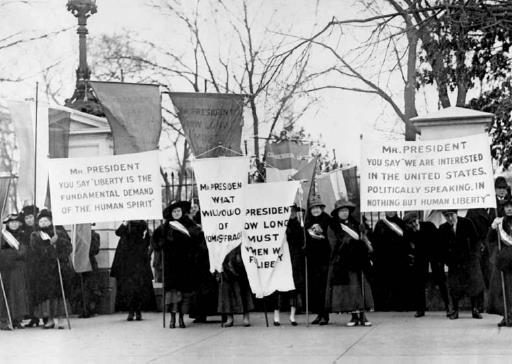Political and Social MovementsSuffragist Movement |
When did the American suffragist movement begin? |
In the 1840s American women began organizing and, in increasing numbers, demanding the right to vote. The movement was started by women who sought social reforms, including outlawing slavery, instituting a national policy of temperance (abstinence from alcoholic beverages), and securing better work opportunities and pay. These reformers soon realized that in order to make change they needed the power of the vote.
Among the leaders of the suffragist movement was feminist and reformer Elizabeth Cady Stanton (1815–1902). She joined with antislavery activist Lucretia Mott (1793–1880) to organize the first women’s rights convention in 1848 in Seneca Falls, New York, launching the woman suffragist movement. In 1869 Stanton teamed with Susan B. Anthony (1820–1906) to organize the National Woman Suffrage Association. That same year, another group was formed: the American Woman Suffrage Association, led by women’s rights and antislavery activist Lucy Stone (1818–1893) and her husband Henry Brown Blackwell (1825–1909). In 1870 the common cause of the two groups was strengthened by the passage of the Fifteenth Amendment, which gave all men, regardless of race, the right to vote. When the two organizations joined forces in 1890, they formed the National American Woman Suffrage Association (NAWSA).
The founders of the American women’s movement were followed by a new generation of leaders, which included Stanton’s daughter, Harriot Eaton Blatch (1856–1940), as well as Alice Paul (1885–1977), who founded the organization that became the National Woman’s Party, and organizer and editor Lucy Burns (1879–1966), who worked closely with Paul.
The suffragists appealed to middle-class and working-class women, as well as to students and radicals. They waged campaigns at the state level, distributed literature, organized meetings, made speeches, and marched in parades. They also lobbied federal legislators, picketed, and chained themselves to the White House fence. When jailed, many resorted to hunger strikes and were sometimes met with cruel treatment. The suffragists’ fight was a fierce one; the opposition played on the widespread belief that if given the right to vote, women would neglect the traditional duties of wife and mother.
The movement gained strength during World War I (1914–18). As men went off to fight the war in Europe, the women at home demonstrated themselves to be intelligent and involved citizens in the life of the country. A wartime suffragist poster declared in one long column, “As a war measure, the country is asking of women service as … farmers, mechanics, nurses, doctors, munitions workers, mine workers, yeomen, gas makers, bell boys, messengers, conductors, motormen, army cooks, telegraphers, ambulance drivers, advisors to the council of national defense,” and in another short column it stated, “As a war measure, women are asking of the country … the vote.” By 1918 support for woman suffrage was broad. That year Congress proposed a constitutional amendment stating that the “right of citizens of the United States to vote shall not be denied or abridged by the United States or by any State on account of sex.” It was passed, as the proposed Nineteenth Amendment, in the House in 1918 and in the Senate in 1919. The amendment was approved by the required number of state legislatures on August 18, 1920, when Tennessee ratified it.

